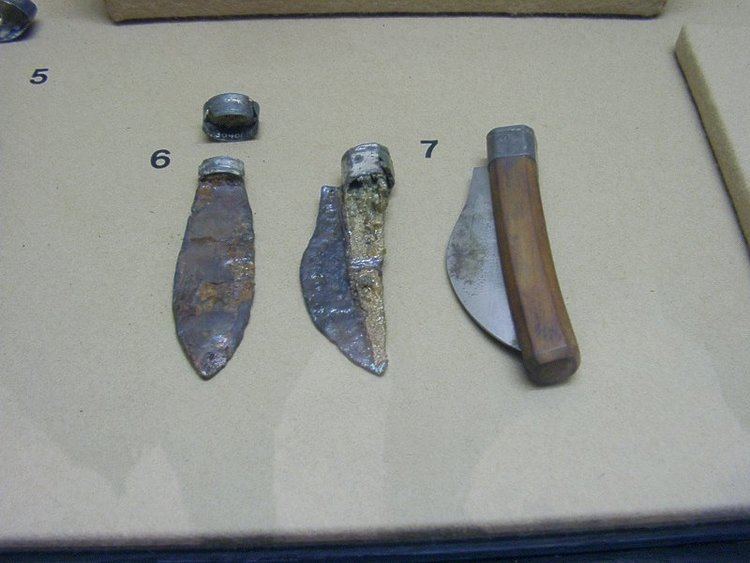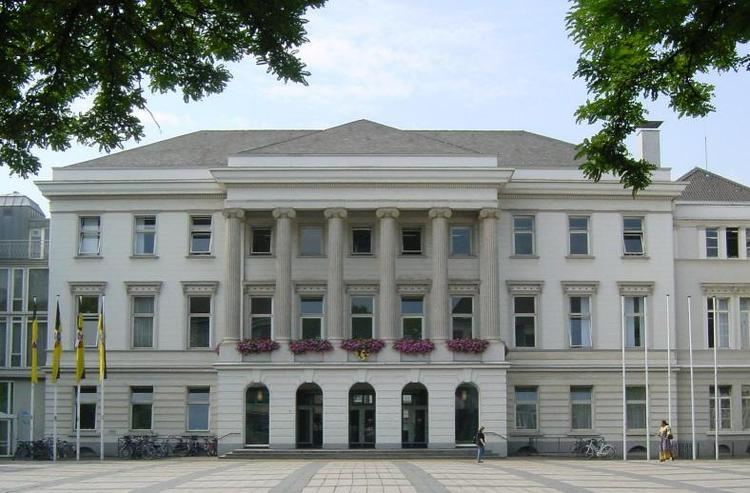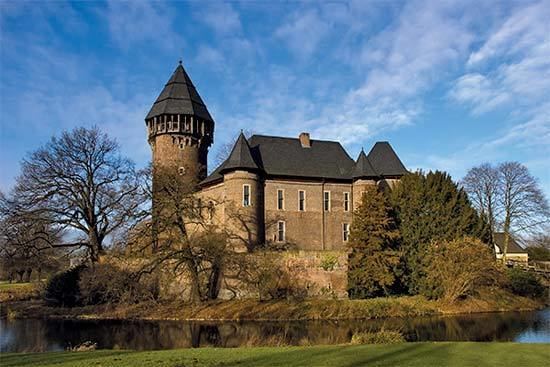Country Area 137.68 km2 | ||
 | ||
Points of interest Haus Lange and Haus Esters, Elfrather See, Grotenburg-Stadion | ||
District Urban districts of Germany | ||
Map of Krefeld
Krefeld ( [ˈkʁeːfɛlt]), also known as Crefeld until 1929, is a city in North Rhine-Westphalia, Germany. It is located northwest of Düsseldorf, its centre lying just a few kilometres to the west of the River Rhine; the borough of Uerdingen is situated directly on the Rhine. Krefeld is accessed by the autobahns A57 (Cologne–Nijmegen) and the A44 (Aachen–Düsseldorf–Dortmund–Kassel).
Contents
- Map of Krefeld
- Spuk lutjens onride krefeld germany
- German tram systems krefeld and duisburg
- History
- The Jews of Krefeld
- Points of interest
- Districts
- Incorporations
- Historical population of Krefeld
- City counsellors 1946 until 1999
- Transport
- Economy
- International relations
- Twin towns Sister cities
- Notable natives
- References

Krefeld is also called the "Velvet and Silk City".

Krefeld's residents speak Hochdeutsch, the standard German taught to all people in Germany. However, the native dialect is a Low German variety, sometimes locally called Krefelder Plattdeutsch, Krieewelsch Platt, Plattdeutsch, or sometimes simply Platt. The Uerdingen line isogloss, separating general dialectical areas in Germany and neighbouring Germanic-speaking countries, runs through and is named after Krefeld's Uerdingen district, originally an independent municipality.
Spuk lutjens onride krefeld germany
German tram systems krefeld and duisburg
History
The town originated in Roman times when the legions founded the military camp of Gelduba (today the borough of Gellep). Records first mention Krefeld itself in 1105 under the name of Krinvelde. Uerdingen, originally an independent town east of Krefeld, founded in 1255, became in medieval times larger and more important than Krefeld.
In February 1598, Walburga, wife of Adolf van Nieuwenaar, and last Countess of Limburg and Moers, gifted the County of Moers, which included Krefeld, to Maurice, Prince of Orange. After her death in 1600, John William of Cleves took possession of these lands, but Maurice successfully defended his heritage in 1601. Krefeld and Moers would remain under the jurisdiction of the House of Orange and the Dutch Republic during the Dutch Golden Age. The growth of the town began in that century, partially because Krefeld was one of few towns spared the horrors of the Thirty Years' War (1618–1648). The town of Uerdingen, incorporated into Krefeld in the 20th century, was less fortunate, almost ceasing to exist, destroyed at the hands of troops from Hesse during the Thirty Years' War. In 1683 a group of thirteen Mennonite families left Krefeld to re-settle in Pennsylvania in order to enjoy religious freedom. They crossed the Atlantic on the ship Concord, and founded the settlement of Germantown (now incorporated in Philadelphia), thus beginning the Pennsylvania Dutch ethnic identity.
After the death of William III of Orange in 1702, Krefeld passed to the Kingdom of Prussia. The Battle of Krefeld occurred nearby in 1758 during the Seven Years' War. Krefeld and Uerdingen were included within the Prussian Province of Jülich-Cleves-Berg in 1815 (after 1822 the Rhine Province). In 1872 Krefeld became an independent city within Rhenish Prussia. In 1918 during the First World Warthe Belgian Army used it as a base during the occupation of the Rhineland.
In 1929 Krefeld and Uerdingen merged to form Krefeld-Uerdingen; in 1940 the name was shortened to simply Krefeld.
On December 11, 1941, during World War II, a detailed report on the transport of Jews from Krefeld and its surroundings listed 1007 Jews from Krefeld and Duisburg, were deported to the Šķirotava Railway Station near Riga, later to become Jungfernhof concentration camp. They were transported in freezing conditions with no drinking-water for more than two days. Almost immediately upon arrival these Jews were shot in the Rumbula forest massacre.
On 21 June 1943 British bombs destroyed large parts of east of the city; a firestorm consumed most of the city center (apart from the central train station, which remained intact apart from minor damage). On 3 March 1945 US troops entered Krefeld, among them the later U.S. Secretary of State Henry Kissinger.
The town became part of the new state of North Rhine-Westphalia after World War II.
The Jews of Krefeld
Jews were listed as citizens of Krefeld from 1617. In 1764 a synagogue was erected, and by 1812, under French rule, the town included 196 Jewish families, with three Jewish-owned banks. Under Napoleon, the town became the capital for the surrounding Jewish communities including over 5000 Jews, and by 1897 they comprised 1.8% of the population. In 1846 a Jewish representative was voted onto the town's municipal council, while rising antisemitism was noted during these elections. A reform synagogue was built in 1876, arousing opposition from the Orthodox community. A Jewish school existed in the town, with more than 200 students around 1900.
In November 1938 during Kristallnacht, the two synagogues were attacked. In 1941 following an order from Hitler to deport the German Jews to the east, Jews from the town were sent to the area around Riga and murdered there. In 1945, the U.S. Army occupied the city and placed Henry Kissinger, then an Army private and later Secretary of State of the United States, in charge of the city administration.
In 2008 a new synagogue, library and Jewish cultural center were erected on the location of one of the demolished synagogues. Around 1100 Jews were reported to live in and around Krefeld at the time.
Points of interest
Districts
There are a number of districts in Krefeld. Each has a municipal representative, with representatives chosen by local elections. The districts are:
Incorporations
Cities and places that were incorporated into Krefeld:
Historical population of Krefeld
¹ Census data
Largest migrant communities in Krefeld are :
City counsellors 1946 until 1999
Transport
Krefeld is connected to the Deutsche Bahn network with several stations, including its main station, Krefeld Hauptbahnhof. They are served by Intercity, Regional-Express and Regionalbahn trains. The Düsseldorf-based Rheinbahn operates a Stadtbahn service to the centrally located Rheinstraße stop. This line was the first electric inter-city rail line in Europe, established in 1898, and commonly called the K-Bahn because of the letter "K" used to denote the trains to Krefeld. Nowadays, in the VRR notation, it is called U76, with the morning and afternoon express trains numbered as U70, the line number there coloured red instead of the usual blue used for U-Bahn lines. The term K-Bahn, however, prevails in common usage.
The city of Krefeld itself operates four tramway and several bus lines under the umbrella of SWK MOBIL, a city-owned company. Since 2010, 19 of the oldest trams of the type DUEWAG GT8 were replaced by modern barrier-free trams of the type Bombardier Flexity Outlook. SWK Mobil owns an option to buy another 19 trams of the same type to replace the last 19 DUEWAG M8 trams. The whole tram fleet will then be barrier-free. Next to that the city plans to extend the line 044 in Krefeld-Hüls to connect the northern district of Hüls with the Krefeld downtown area.
Economy
The headquarters of Fressnapf, a pet food retailer franchise company, are situated in Krefeld.
International relations
Since 1964, the city has hosted an "honors program in foreign language (German) studies" for high school students from Indiana, United States. The program annually places approximately thirty carefully selected high school juniors with families in and around Krefeld for intensive German language training. Since 1973, the fire services of Krefeld and twin city Leicester have played each other in an annual 'friendly' football match.
Twin towns – Sister cities
Krefeld is twinned with:
Notable natives
Scientists:
Writers, poets and journalists:
Musicians:
Artists:
Aviators:
Athletes:
Knights Cross Holder:
Other:
